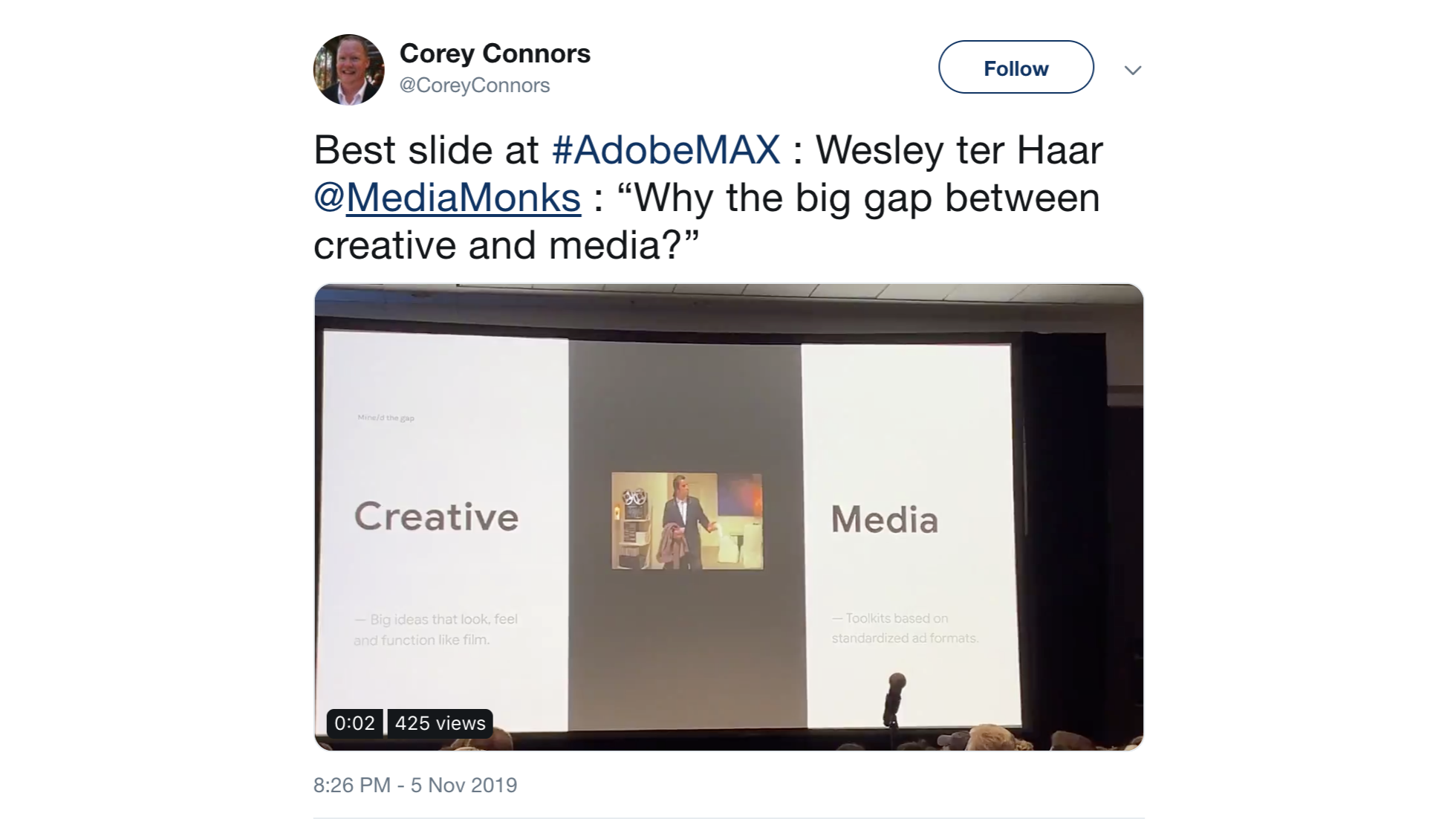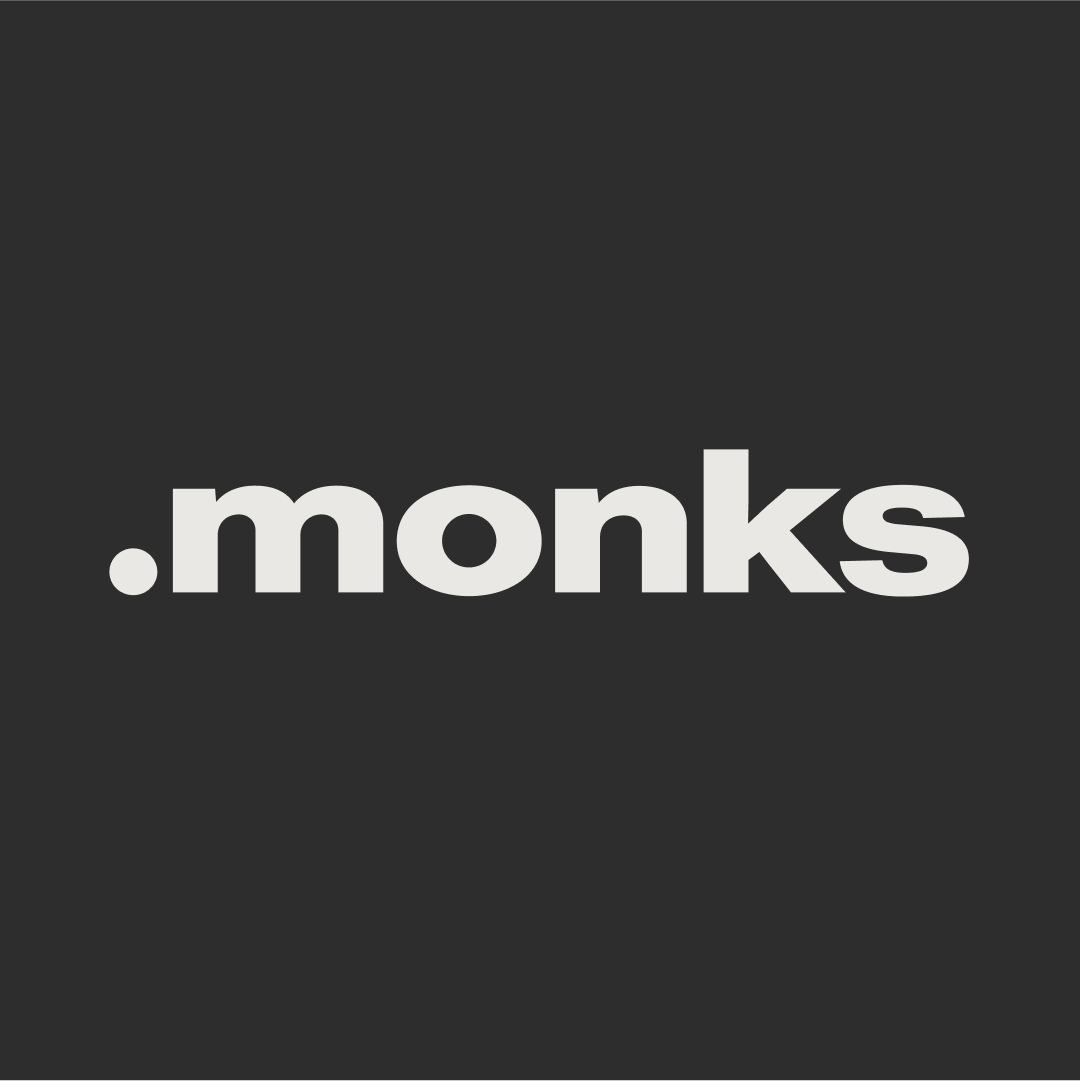3 Lessons for Brands from Adobe MAX 2019

Adobe MAX came and went this week in LA, bringing creative professionals together with hundreds of sessions, workshops and talks. Aiming to inspire the current and next generation of creatives, the event offered rousing insights into the state of creativity today—and opportunities that artists, entertainers and brands alike can look forward to in the near future, including the next stage in storytelling defined by MediaMonks Founder and COO Wesley ter Haar, who presented at the event.
The conference began with Adobe unveiling a slew of new product updates and features, each bringing the company closer to its vision of enabling “Creativity for all,” which served as a bit of a rallying cry at the event. These announcements included Photoshop Camera, which uses machine learning to offer advanced photo filters and quick, intuitive editing; Premiere Rush, which notably lets users create and share out content to creative social platform TikTok; Adobe Aero, which lets anyone develop AR experiences without coding knowledge; and much more.

One of the biggest conferences on creativity, this year’s Adobe MAX offered much to think about in terms of identity, voice and emotionally resonant experiences. As Adobe aims to unlock creativity for everyone, it will become even more essential that brands differentiate by building emotional resonance through the experiences they offer.

MediaMonks was in good company at the UX Leaders Summit hosted at the conference.
At the heart of software like Photoshop Camera is Adobe Sensei, the company’s decidedly not-very-humanlike assistant. At a time when many have concerns over how AI will influence professional (and creative) life, Adobe markets Sensei as simply a tool that helps humans focus on what only they can do: be creative, with Sensei handling the manual processes that function as a barrier to that. But when everyone has advanced creative tools at their fingertips, what does it take to stand out? We’ve extracted a handful of key creative insights from the course of the event.
Know Your Message and What You Stand For
Of course, being a conference centered on creativity, Adobe MAX featured several voices from the world of arts and entertainment. While their insights were delivered to an audience of creatives and designers, a lot of what they had to say serves as good advice for business, too—after all, being an artist in the modern world requires a bit of an entrepreneurial edge.
Visual artist Shantell Martin opened day two’s keynote segment with an inspiring talk about stylistic voice and identity. “You have to make people care for you by caring for yourself first,” she told the audience. Further in her talk, she noted that “You don’t discover your style, you extract it.”
You have to make people care for you by caring for yourself first.
The advice applies well to brands still defining a sense of purpose. For anyone to adopt your brand—and to truly differentiate it—you must first have a good hold on what its purpose is and what you stand for. This also makes it useful to consider how that purpose might resonate differently with different audiences. Digital-native brands in particular have succeeded in this by defining themselves out of a specific need or white space, then leveraging digital channels to align with consumers through that shared sense of purpose.
Take Comfort in Discomfort
Earlier in the conference, illustrator Lisa Congdon offered her own excellent advice on artist voice: “[Finding your voice is] both an exercise in discipline and process of discovery that allows for—and requires—loads of experimentation and failure.” While that’s certainly true for brand voice, it also applies to the innovation imperative.
Innovation requires you not only understand what your brand aims to achieve, but also have an intimate understanding of your audience and how they interact. In an age of hyperadoption, real innovation comes from evolving your brand experience in lockstep with user behaviors and continual experimentation. Congdon recommends that creatives adopt a learner’s mindset that’s open to risks and embraces discomfort—an attitude that not only fosters a creative environment but can also kickstart more agile ways of working.
Open a New Chapter in the Story of Storytelling
All of the above boils down to ensuring your message truly resonates with your audience. Throughout history, humans have used the power of narrative and storytelling to achieve this, but interactive digital culture has upended the storytelling norms that had traditionally prevailed. In an on-stage interview with Jason Levine, Principal Worldwide Evangelist for Adobe Creative Cloud, famed director M. Night Shyamalan remarked that “Everything in today’s society goes back to storytelling. Right now, we’re split between fighting for the old story, and fighting for the new story. It’s time to bring in the new story.”

Wesley ter Haar's talk focused on the power of digital storytelling and what makes it so unique.
What does that new story look like? That’s what Wesley ter Haar aimed to define in his talk, “Augmented Creativity: Emerging Platforms that Drive the Next Generation of Storytelling.” Ter Haar railed against the variations of storytelling that frequently pop up at conferences—like “storydoing” or “storymaking”—by noting that each still relies on the same form of linear narrative that today’s marketeers should break away from. “We’ve taken what is this amazing medium for creativity and innovation—the web, the internet or what we now call digital—but we’ve made it about traditional linear formats,” he says.
Netflix’s Bandersnatch might have brought interactive film to the masses last year, for instance, but it was hardly groundbreaking or immersive compared to what’s come before it; video games had already explored what ter Haar calls the “interrupt to interact” narrative model for decades, and we’ve moved away from truly personalized experiences enabled by an API-driven open web. And when it comes to personalization as it’s commonly used, says ter Haar, “There’s a lot of engineering, but very little empathy.”

In a new era of ecosystems and total brand experience, ter Haar calls for a new definition of storytelling: “A journey focused on the user that creates a personal path, driven by design and distinction, powered by innovation.” And these stories should show no end, either: “Digital storytelling is more input-based, trying to get the next ‘yes, and…’ moment,” says ter Haar, noting how each piece of content ideally leads into the next step within a content ecosystem. To offer stories that truly resonate, brands must use storytelling to bridge together creative and media. This requires breaking away from big ideas that function like film, and instead drive impact by recognizing user behaviors and shifting toward an insight-driven focus on the customer experience.
Related
Thinking
Sharpen your edge in a world that won't wait
Sign up to get email updates with actionable insights, cutting-edge research and proven strategies.
Monks needs the contact information you provide to us to contact you about our products and services. You may unsubscribe from these communications at any time. For information on how to unsubscribe, as well as our privacy practices and commitment to protecting your privacy, please review our Privacy Policy.



